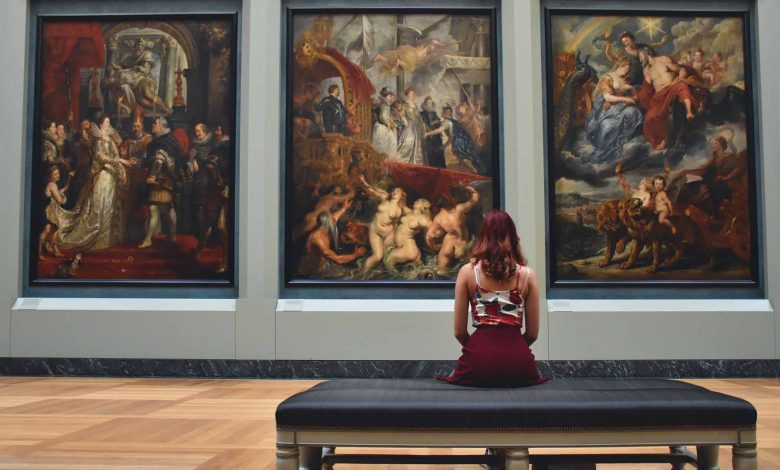How Blockchain Is Changing the Art World

- Introduction to Blockchain Technology
- The Impact of Blockchain on Art Authentication
- Revolutionizing Art Ownership with Blockchain
- Enhancing Transparency in Art Sales
- Challenges and Opportunities for Artists in the Blockchain Era
- Exploring the Future of Art Collecting with Blockchain
Introduction to Blockchain Technology
Blockchain technology is revolutionizing the art world by providing a secure and transparent way to buy, sell, and authenticate artwork. This innovative technology allows for the creation of a digital ledger that records all transactions in a decentralized and immutable manner. This means that every transaction is securely recorded and cannot be altered or tampered with, ensuring the authenticity and provenance of artworks.
One of the key benefits of blockchain technology in the art world is the ability to create digital certificates of authenticity. These certificates are stored on the blockchain, providing a secure and verifiable record of an artwork’s provenance. This helps to combat issues such as art forgery and ensures that collectors can trust the authenticity of the pieces they are purchasing.
Additionally, blockchain technology enables artists to receive fair compensation for their work through the use of smart contracts. These self-executing contracts automatically transfer payments to artists when their work is sold, eliminating the need for intermediaries and ensuring that artists receive their fair share of the proceeds.
Overall, blockchain technology is transforming the art world by providing a secure and transparent way to buy, sell, and authenticate artwork. By leveraging the power of blockchain, the art world is becoming more accessible, efficient, and trustworthy for artists, collectors, and enthusiasts alike.
The Impact of Blockchain on Art Authentication
Blockchain technology has revolutionized the way art authentication is done in the art world. By utilizing blockchain, artists, collectors, and galleries can securely verify the authenticity of artworks, track provenance, and ensure transparency in transactions. This has significantly reduced the risk of art fraud and forgery, providing a level of trust and security that was previously unattainable.
One of the key benefits of using blockchain for art authentication is the ability to create a digital certificate of authenticity that is tamper-proof and immutable. This certificate is stored on the blockchain, making it easily accessible to anyone who wants to verify the authenticity of an artwork. This not only simplifies the authentication process but also eliminates the need for physical certificates that can be easily forged or lost.
Moreover, blockchain technology allows for the creation of a decentralized database of art transactions, ensuring that all information related to an artwork, including its ownership history, is securely recorded and cannot be altered. This provides a clear and transparent record of an artwork’s provenance, making it easier for buyers to verify the authenticity of a piece before making a purchase.
In addition to enhancing security and transparency in art authentication, blockchain also has the potential to revolutionize the way art is bought and sold. By using smart contracts, artists can receive royalties automatically whenever their work is resold, ensuring that they continue to benefit from their creations even after the initial sale. This has the potential to empower artists and create a more equitable art market for all stakeholders involved.
Overall, the impact of blockchain on art authentication is undeniable. It has brought a new level of trust, security, and transparency to the art world, making it easier for artists, collectors, and galleries to verify the authenticity of artworks and track their provenance. As blockchain technology continues to evolve, its influence on the art market is only expected to grow, shaping the future of the industry in unprecedented ways.
Revolutionizing Art Ownership with Blockchain
Blockchain technology is revolutionizing the way art ownership is managed and verified. By utilizing blockchain, art collectors and investors can securely track the provenance and authenticity of artworks. This decentralized system provides a transparent and immutable record of ownership, eliminating the need for intermediaries and reducing the risk of fraud.
Enhancing Transparency in Art Sales
Blockchain technology is revolutionizing the art world by enhancing transparency in art sales. This innovative technology allows for secure and verifiable transactions, providing a level of trust and authenticity that was previously difficult to achieve. Through the use of blockchain, each art piece can be assigned a unique digital signature, creating a permanent record of its ownership history.
By utilizing blockchain, art buyers can have confidence in the provenance of a piece, knowing that the information they receive is accurate and tamper-proof. This increased transparency helps to combat issues such as art fraud and forgery, which have plagued the art market for years. Additionally, blockchain technology allows for greater accessibility to information about art sales, making it easier for collectors, galleries, and artists to track the value and ownership of artworks.
Overall, the implementation of blockchain in the art world is leading to a more secure and efficient marketplace. With its ability to provide a transparent and immutable record of transactions, blockchain is changing the way art is bought and sold, bringing a new level of trust and accountability to the industry.
Challenges and Opportunities for Artists in the Blockchain Era
Artists in the blockchain era face a unique set of challenges and opportunities that come with the integration of this technology into the art world. One of the main challenges is the need for artists to adapt to the new digital landscape and understand how blockchain can be used to their advantage. This requires a certain level of technical knowledge and a willingness to explore new ways of creating and distributing art.
On the other hand, blockchain also presents artists with exciting opportunities to revolutionize the way they interact with their audience and the art market as a whole. By using blockchain technology, artists can create digital certificates of authenticity for their work, ensuring that each piece is unique and cannot be replicated or forged. This can help to combat issues of art forgery and increase trust between artists, collectors, and galleries.
Furthermore, blockchain allows for greater transparency in the art world, making it easier for artists to track the provenance of their work and ensure that they are fairly compensated for their creations. Smart contracts can be used to automate royalty payments and ensure that artists receive a portion of the resale value of their work, even after it has changed hands multiple times.
Exploring the Future of Art Collecting with Blockchain
One of the most exciting developments in the art world is the integration of blockchain technology into the art collecting process. Blockchain has the potential to revolutionize how art is bought, sold, and authenticated, providing a secure and transparent way for collectors to track the provenance of their pieces.
By using blockchain, collectors can have a digital record of every transaction involving a piece of art, from its creation to its current ownership. This not only helps to prevent fraud and forgery but also gives collectors peace of mind knowing that they have a complete and accurate history of their artwork.
Furthermore, blockchain technology allows for the fractional ownership of art, making it more accessible to a wider range of collectors. This means that individuals who may not have the means to purchase an entire piece of art can still invest in a portion of it, opening up new opportunities for art enthusiasts to participate in the market.
Overall, the future of art collecting with blockchain looks promising, offering increased security, transparency, and accessibility for collectors around the world. As this technology continues to evolve, we can expect to see even more innovative ways in which blockchain is changing the art world for the better.






